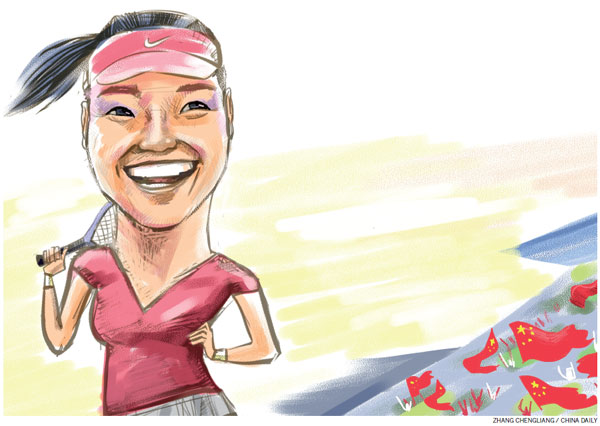

The way Li Na has been marketed reveals much about modern China
Few will have not noticed Chinese tennis star Li Na's recent victory at the Australian Open in Melbourne, such is the level of global recognition she now enjoys. But many will remain unaware of the commercial significance of Li's latest Grand Slam triumph, especially the sponsorship value of brand Li Na.
The Australian Open win was Li Na's second Grand Slam title, the other being the French Open at Roland Garros in 2011, but more importantly for brand Li Na, these successes have been achieved in her late 20s and her early 30s. In fact, Li is the only female post-30 year-old winner of a major tennis tournament since the Englishwoman Virginia Wade won the Wimbledon title in 1978, also aged 31.
But what is even more remarkable than Li Na's success at such a relatively late stage in her career is the financial value of the brand endorsements. Since winning the French Open less than three years ago, her revenue from brand endorsements has totaled $42 million (31 million euros). She sponsors 13 brands, among them the most recognizable of global brands such as Mercedes-Benz and Rolex.
Her global popularity, based on a hugely attractive, entertaining and maverick personality, is perhaps best put into perspective by the number of followers she has on China's social media site Sina Weibo: 22 million plus, more than the number of Twitter followers, combined, of Roger Federer, Rafael Nadal, Novak Djokovic, Serena Williams, Maria Sharapova and Victoria Azarenka.
Furthermore, Li was recently named one of Time magazine's 100 most influential people in the world, one of only four sports people on the list, and one of only seven selected for individual covers.
But how has Li achieved such success at such an age and established herself as so much more than a top tennis player and become a global media mega star?
The key reasons are entirely consistent with those behind most global product/brand success stories.
First, Li has demonstrated tremendous tenacity and dedication in pursuing tennis' most important trophies. She was 28 when she won the French Open, having turned professional many years earlier.
She possesses extremely strong, inner self-belief and strength of character. She has done it her way. To build her career internationally she famously and acrimoniously split from the Chinese Tennis Association in 2008.
The road to global brand success is littered with similar examples of what appeared to be highly questionable, almost maverick, initiatives. For example, Nike was widely ridiculed for its investment in then unknown, fledgling basketball professional Michael Jordan. The pioneering loyalty scheme Clubcard of the UK food retailer Tesco met with a similar reaction.
Investment is also an important factor behind Li's rise, and something that has been embraced and not at all perceived as a financial burden. Perhaps Li's hiring Carlos Rodriguez as her coach in July 2012 represents her greatest investment. Until then her husband had been her coach. Rodriguez, most noted for the success he enjoyed as long-time coach of former world No 1 Justine Henin, did not come cheaply, but soon after his appointment many could see the formation of an extremely compatible partnership. Many in the tennis world also acknowledge the contribution of Rodriguez in revitalizing Li's career after a slump following her French Open win.
Li has also shown shrewd management and even entrepreneurial acumen with her choice of an agent, Max Eisenbud, who also manages Maria Sharapova. As with Rodriguez, Eisenbud and his sports agency IMG were not cheap, but this was also seen as an investment rather than a cost.
One of the reasons behind Chinese brands' sluggish expansion overseas is the conservative approach to investment. Brand Li Na is a prime example of just how an investment-led approach in high value-adding brand associations pays off.
IMG, founded in 1960 by the late US entrepreneur Mark McCormack, is widely recognized as a leader in the global sports, fashion and media business with more than 3,500 employees in more than 30 countries.
But beyond all these very rational brand attributes, all successful brands require layer upon layer of emotional values, and this is where Li excels so naturally with her magnetic personality.
While it is her natural charm and in particular her sense of humor that capture most of the headlines, she has also said publicly many times that her main ambition in life is to become a mother, and a good one. Clearly, the public has warmed to an extremely entertaining, charismatic and media-savvy person who also possesses genuine warmth and sincerity and, therefore, trust.
Brand building research over the years has led to the publication of numerous "models" constructed to enable effective and sustainable brand development. Two of the best known and most widely used are Jennifer Aaker's dimensions of brand personality framework (1997) and Susan Fournier's consumers and their brands: developing relationship theory in consumer research (1998).
The main reasons for the widespread use of these models, as evidenced by the considerable number of citations over recent years, is their attention to emotional attachment between consumers and the brands they consume. This is precisely why brand Li Na has had such a roaring success.
Specifically, Aaker's research findings point conclusively to the importance of "sincerity" and "excitement" in any brand building success, and Fournier provides ample evidence to suggest that the most successful brands are indeed perceived as a good or even best "friend".
Brand Li Na's image, now with global reach, can be seen as consistent with the findings above.
As a result, Li's brand image has now transcended tennis and even sport, so it represents a perfect brand association opportunity for brands across industries and cultures.
In addition, Li's incredible journey and mega-star status provide a tremendous boost to China's image. This could not come at a more important time as the Chinese economy desperately searches for a far more modern image internationally.
European companies not just view Li Na as the perfect tie-up to tap into China's huge consumer market but should also understand the not inconsiderable catalyst toward modernization, innovation and openness her success is producing.
Brand Li Na is not just a personal success story but a microcosm of modernizing China. European industry can learn much about brand building from Li's story but also much more about the nature and rate of change in Chinese consumer culture.
The author is a visiting professor at the University of International Business and Economics in Beijing and a senior lecturer on marketing at Southampton Solent University's School of Business. The views do not necessarily reflect those of China Daily.

(China Daily Africa Weekly 03/07/2014 page14)








